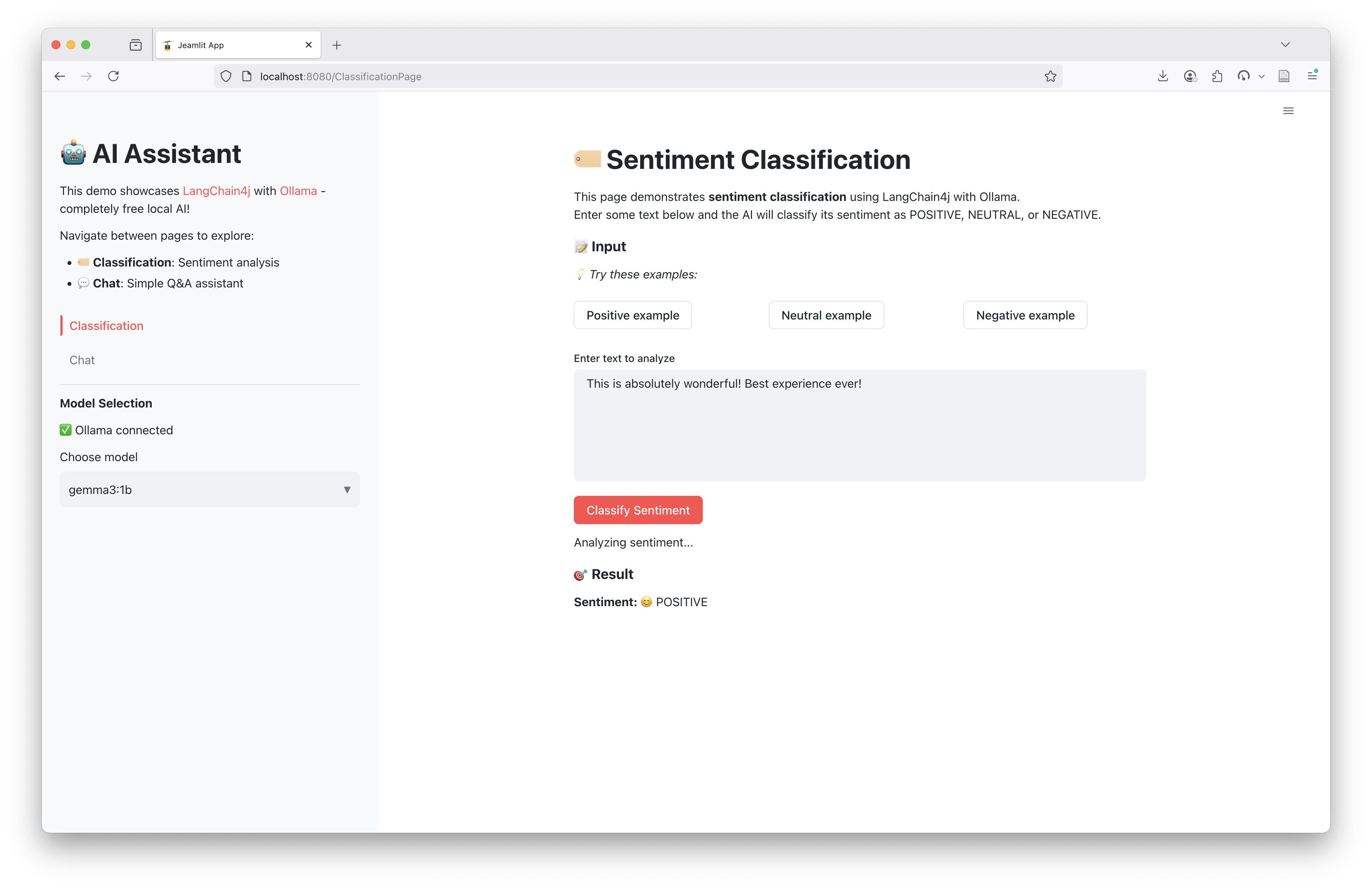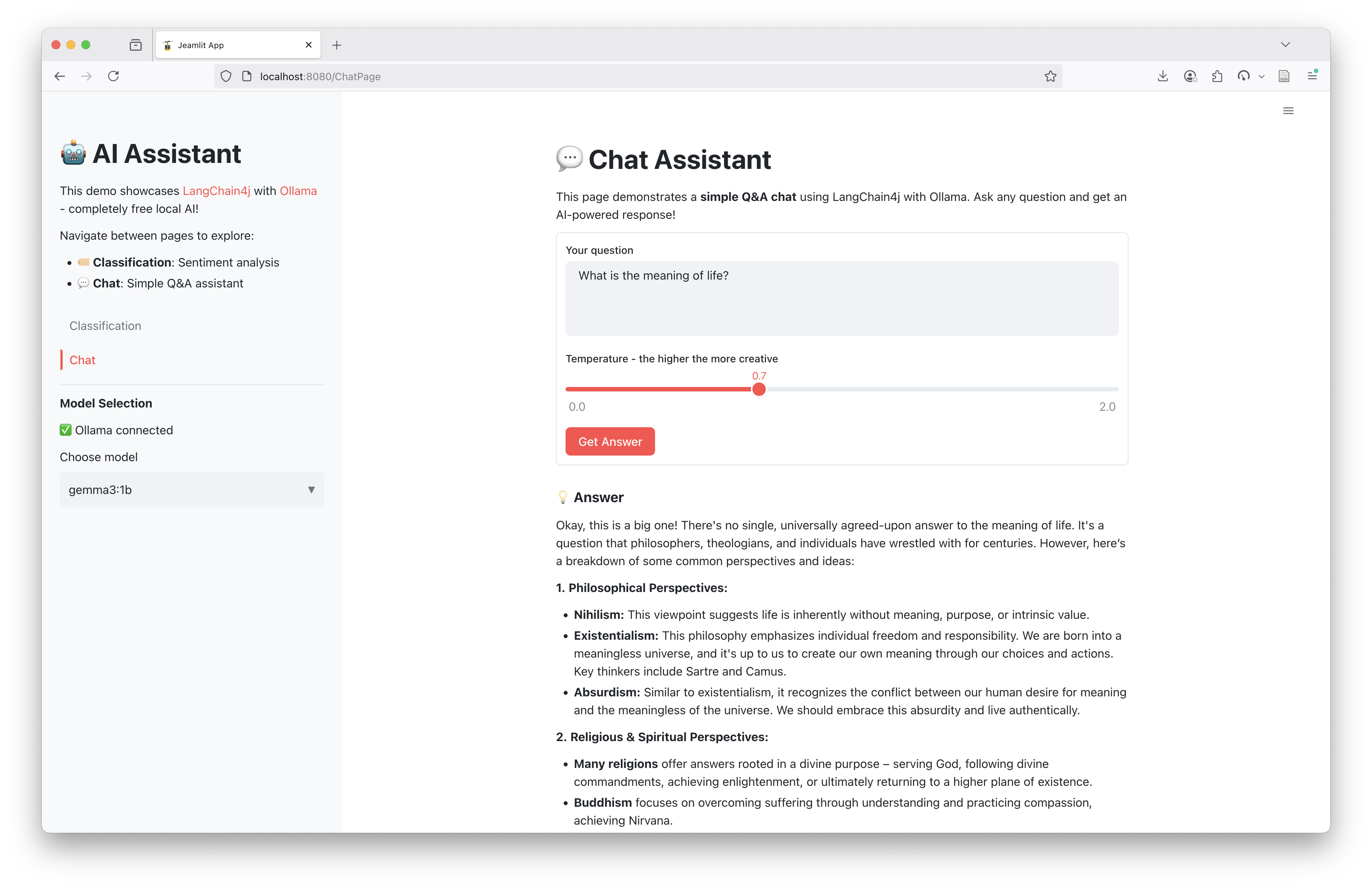Create a multipage app
In Additional features, we introduced multipage apps, including how to define pages, structure and run multipage apps, and navigate between pages in the user interface. You can read more details in our guide to Multipage apps.
In this tutorial, we'll build a multipage AI Assistant app using Ollama as a local AI model provider and LangChain4j in Java as the client library. This demonstrates key concepts like page navigation, session state management, and how the main app acts as a shared canvas for all pages. We will also encounter advanced concepts like forms and empty containers.
Prerequisites
Before starting, ensure you have:
- Ollama installed and running (
ollama serve) - Required models pulled:
ollama pull gemma3:270mandollama pull gemma3:1b
Tip
You can find the app files here: https://github.com/jeamlit/jeamlit/tree/main/examples/multipage_ai
Try it out before reading further with:
jeamlit run https://github.com/jeamlit/jeamlit/tree/main/examples/multipage_ai
App structure
Our multipage app will have this structure:
AIAssistant.java # Main entrypoint
pages/
├── ClassificationPage.java
└── ChatPage.java
Create the main entrypoint
The main entrypoint (AIAssistant.java) serves as the canvas for all pages. Elements placed in this entrypoint
appear on every page. The current page is run via currentPage.run().
/// usr/bin/env jbang "$0" "$@" ; exit $?
//DEPS io.jeamlit:jeamlit:0.44.0
//DEPS dev.langchain4j:langchain4j:0.36.2
//DEPS dev.langchain4j:langchain4j-ollama:0.36.2
import java.net.HttpURLConnection;
import java.net.URL;
import java.util.List;
import io.jeamlit.core.Jt;
import io.jeamlit.core.Shared;
import pages.ChatPage;
import pages.ClassificationPage;
public class AIAssistant {
public static void main(String[] args) {
// Sidebar configuration - appears on ALL pages
Jt.title("🤖 AI Assistant").use(Jt.SIDEBAR);
// About section - appears on ALL pages
Jt.markdown("""
This demo showcases [LangChain4j](https://docs.langchain4j.dev) with [Ollama](https://ollama.ai) - completely free local AI!
Navigate between pages to explore:
- 🏷️ **Classification**: Sentiment analysis
- 💬 **Chat**: Simple Q&A assistant
""").use(Jt.SIDEBAR);
// Define navigation with multiple pages
JtPage currentPage = Jt
.navigation(Jt.page(ClassificationPage.class).title("Classification").home(),
Jt.page(ChatPage.class).title("Chat"))
.use();
// Model selector in sidebar - appears on ALL pages
boolean ollamaRunning = checkOllamaConnection();
if (ollamaRunning) {
Jt.markdown("**Model Selection**").use(Jt.SIDEBAR);
Jt.text("✅ Ollama connected").use(Jt.SIDEBAR);
String currentModel = Jt.sessionState().getString("selected_model", "gemma3:270m");
List<String> models = List.of("gemma3:270m", "gemma3:1b");
String selectedModel = Jt.selectbox("Choose model", models)
.index(models.indexOf(currentModel))
.use(Jt.SIDEBAR);
// Check if the selected model is loaded in Ollama
if (isModelLoaded(selectedModel)) {
// Store model in session state for pages to access
Jt.sessionState().put("selected_model", selectedModel);
// Execute the current page - this is where page content starts to execute
currentPage.run();
} else {
// model is not available - display error message
String errorMsg = """
⚠️ Model not available. \s
Run: \s
`ollama run %s` \s
and refresh this page. \s
Or make sure the model was not paused automatically by ollama!
""".formatted(selectedModel);
Jt.error(errorMsg).use();
}
} else {
Jt.error("⚠️ Ollama is not running on port `11434`. Start ollama by running `ollama serve` and refresh this page.").use();
}
}
private static boolean checkOllamaConnection() {
try {
URL url = new URL("http://localhost:11434/api/tags");
HttpURLConnection conn = (HttpURLConnection) url.openConnection();
conn.setRequestMethod("GET");
conn.setConnectTimeout(2000);
conn.setReadTimeout(2000);
int responseCode = conn.getResponseCode();
conn.disconnect();
return responseCode == 200;
} catch (Exception e) {
return false;
}
}
private static boolean isModelLoaded(String modelName) {
try {
final URL url = new URL("http://localhost:11434/api/ps");
final HttpURLConnection conn = (HttpURLConnection) url.openConnection();
conn.setRequestMethod("GET");
conn.setConnectTimeout(2000);
conn.setReadTimeout(2000);
if (conn.getResponseCode() != 200) {
return false;
}
// Parse JSON response using Jackson
final var json = Shared.OBJECT_MAPPER.readValue(conn.getInputStream(), java.util.Map.class);
conn.disconnect();
// Check if the model field matches our selected model
final var models = (java.util.List<java.util.Map<String, Object>>) json.get("models");
if (models != null) {
for (var model : models) {
if (modelName.equals(model.get("model"))) {
return true;
}
}
}
return false;
} catch (Exception e) {
return false;
}
}
}
Key concepts
1. Page Navigation
The Jt.navigation() method defines which pages are available:
JtPage currentPage = Jt
.navigation(Jt.page(ClassificationPage.class).title("Classification").home(),
Jt.page(ChatPage.class).title("Chat"))
.use();
This returns a JtPage object representing the currently selected page. Call currentPage.run() to execute that page's main() method.
2. The Canvas Pattern
Elements placed before and after currentPage.run() appear on all pages:
- Sidebar title and about section
- Model selection dropdown
- Connection status
Remember, Jeamlit apps are resolved top to bottom. While the Jt.navigation and currentPage.run() automatically add
a table of content in the sidebar and URL paths management, the app is still executed top to bottom. In this demo,
the entrypoint app does not call the current page if the ollama model is not available. The preconditions checks are not
duplicated in all pages!
3. Session State for Shared Data
Session state allows sharing data between the main app and pages:
// Main app stores the selected model
Jt.sessionState().put("selected_model", selectedModel);
// Pages retrieve the selected model
String modelName = Jt.sessionState().getString("selected_model", "gemma3:270m");
This pattern is crucial for multipage apps - the model selection in the sidebar is available to both pages without duplicating code.
Create the pages
Now let's create the two page classes. Each page is a separate Java class with a main() method.
Classification Page
package pages;
//DEPS io.jeamlit:jeamlit:0.44.0
//DEPS dev.langchain4j:langchain4j:0.36.2
//DEPS dev.langchain4j:langchain4j-ollama:0.36.2
import dev.langchain4j.model.ollama.OllamaChatModel;
import dev.langchain4j.service.AiServices;
import dev.langchain4j.service.UserMessage;
import io.jeamlit.core.Jt;
public class ClassificationPage {
// Define the Sentiment enum
enum Sentiment {
POSITIVE,
NEUTRAL,
NEGATIVE
}
// Define the AI-powered Sentiment Analyzer interface
interface SentimentAnalyzer {
@UserMessage("Analyze sentiment of {{it}}")
Sentiment analyzeSentimentOf(String text);
}
public static void main(String[] args) {
Jt.title("🏷️ Sentiment Classification").use();
Jt.markdown("""
This page demonstrates **sentiment classification** using LangChain4j with Ollama. \s
Enter some text below and the AI will classify its sentiment as POSITIVE, NEUTRAL, or NEGATIVE.
""").use();
// Get model from session state (shared by main app)
String modelName = Jt.sessionState().getString("selected_model", "gemma3:270m");
// Text input for classification
Jt.markdown("""
### 📝 Input
*💡 Try these examples:*
""").use();
// Example buttons
String exampleValue = Jt.sessionState().computeIfAbsentString("input", k -> "I love this product! It's amazing and works perfectly.");
var col1 = Jt.columns(3).use();
if (Jt.button("Positive example").use(col1.col(0))) {
exampleValue = "This is absolutely wonderful! Best experience ever!";
}
if (Jt.button("Neutral example").use(col1.col(1))) {
exampleValue = "The product works as described. Nothing special.";
}
if (Jt.button("Negative example").use(col1.col(2))) {
exampleValue = "Terrible quality. Very disappointed with this purchase.";
}
Jt.sessionState().put("input", exampleValue);
String text = Jt
.textArea("Enter text to analyze")
.value(exampleValue)
.height(150)
.use();
// Classify button
if (Jt.button("Classify Sentiment").type("primary").use()) {
if (text.trim().isEmpty()) {
Jt.text("Please enter some text to analyze.").use();
} else {
try {
Jt.text("Analyzing sentiment...").use();
// Create Ollama model
var chatModel = OllamaChatModel
.builder()
.baseUrl("http://localhost:11434")
.modelName(modelName)
.temperature(0.3)
.build();
// Create AI-powered Sentiment Analyzer
SentimentAnalyzer analyzer = AiServices.create(SentimentAnalyzer.class, chatModel);
// Analyze sentiment
Sentiment sentiment = analyzer.analyzeSentimentOf(text);
// Display result
Jt.markdown("### 🎯 Result").key("classi-result").use();
String emoji = switch (sentiment) {
case POSITIVE -> "😊";
case NEUTRAL -> "😐";
case NEGATIVE -> "😞";
};
Jt.markdown("**Sentiment:** %s %s".formatted(emoji, sentiment)).use();
} catch (Exception e) {
throw e;
}
}
}
}
}

Chat Page
package pages;
//DEPS io.jeamlit:jeamlit:0.44.0
//DEPS dev.langchain4j:langchain4j:0.36.2
//DEPS dev.langchain4j:langchain4j-ollama:0.36.2
import dev.langchain4j.model.ollama.OllamaChatModel;
import dev.langchain4j.service.AiServices;
import dev.langchain4j.service.SystemMessage;
import dev.langchain4j.service.UserMessage;
import dev.langchain4j.service.V;
import io.jeamlit.core.Jt;
import io.jeamlit.core.JtContainer;
public class ChatPage {
// Define the AI Assistant interface
interface Assistant {
@SystemMessage("You are a helpful AI assistant. Provide clear, concise, and accurate answers.")
@UserMessage("{{question}}")
String chat(@V("question") String question);
}
public static void main(String[] args) {
Jt.title("💬 Chat Assistant").use();
Jt.markdown("""
This page demonstrates a **simple Q&A chat** using LangChain4j with Ollama.
Ask any question and get an AI-powered response!
""").use();
// Get model from session state (shared by main app)
String modelName = Jt.sessionState().getString("selected_model", "gemma3:270m");
// Form prevents reruns when typing - only reruns when button clicked
JtContainer formContainer = Jt.form().use();
String question = Jt.textArea("Your question")
.value("What is the meaning of life?")
.height(100)
.placeholder("Enter your question here...")
.use(formContainer);
// Temperature slider - adjustable per request
double temperature = Jt.slider("Temperature - the higher the more creative")
.min(0.0)
.max(2.0)
.value(0.7)
.step(0.1)
.use(formContainer);
// Form submit button
if (Jt.formSubmitButton("Get Answer").type("primary").use(formContainer)) {
if (question.trim().isEmpty()) {
Jt.text("Please enter a question.").use();
} else {
try {
// Empty container allows updating content in place
var inPlaceContainer = Jt.empty("load-and-answer").use();
// Show loading state
Jt.text("Thinking...").use(inPlaceContainer);
// Create Ollama model
var chatModel = OllamaChatModel.builder()
.baseUrl("http://localhost:11434")
.modelName(modelName)
.temperature(temperature)
.build();
// Create AI-powered Assistant
Assistant assistant = AiServices.create(Assistant.class, chatModel);
// Get answer
String answer = assistant.chat(question);
// Replace loading state with answer
Jt.markdown("### 💡 Answer\n" + answer).use(inPlaceContainer);
} catch (Exception e) {
Jt.error("Error getting answer: " + e.getMessage()).use();
}
}
}
}
}

The Chat page demonstrates two advanced patterns for better user experience:
1. Forms for controlled reruns
As explained in the basic concepts, a Jeamlit app re-runs
top-to-bottom every time a widget value is changed. Without a form, changing the text area or temperature slider
would trigger a full app rerun. With a form, the app only reruns when the submit button Get answer is clicked.
Forms prevent the app from rerunning on every widget change.
JtContainer formContainer = Jt.form().use();
// Add inputs to form
String question = Jt.textArea("Your question").use(formContainer);
double temperature = Jt.slider("Temperature").use(formContainer);
// app only reruns when this button is clicked
if (Jt.formSubmitButton("Get Answer").use(formContainer)) { ... }
Learn more: Forms documentation
2. Empty containers for dynamic updates
Empty containers allow replacing content in place without adding new elements. This creates a smooth loading → result transition:
var inPlaceContainer = Jt.empty("load-and-answer").use();
Jt.text("Thinking...").use(inPlaceContainer); // Show loading state
// ... AI processing ...
Jt.markdown("### Answer\n" + answer).use(inPlaceContainer); // Replace with result
Learn more: Animation documentation
Run the multipage app
To run your multipage app:
jeamlit run AIAssistant.java
The app will:
- Display the sidebar with navigation, about section, and model selector on all pages
- Allow switching between Classification and Chat pages
- Share the selected model between pages via session state
- Show page-specific content in the main area
It's never been so easy to try and demo LangChain4j!
Next steps
Congratulations! 🎉 If you've read this far, chances are you've learned to create both single-page and multipage apps. Where you go from here is entirely up to your creativity! We’re excited to see what you’ll build now that adding additional pages to your apps is easier than ever. Try adding more pages to the app we've just built as an exercise. Also, stop by the forum to show off your multipage apps with the Jeamlit community! 🚡
Here are some resources to continue learning:
- Post a question or share your multipage app on our community forum.
- Explore the full Multipage apps documentation
- Learn about Forms for controlled reruns
- Discover Animation techniques with empty containers
- Browse the API reference for all Jeamlit components
Still have questions?
Go to our discussions forum for helpful information and advice from Jeamlit experts.